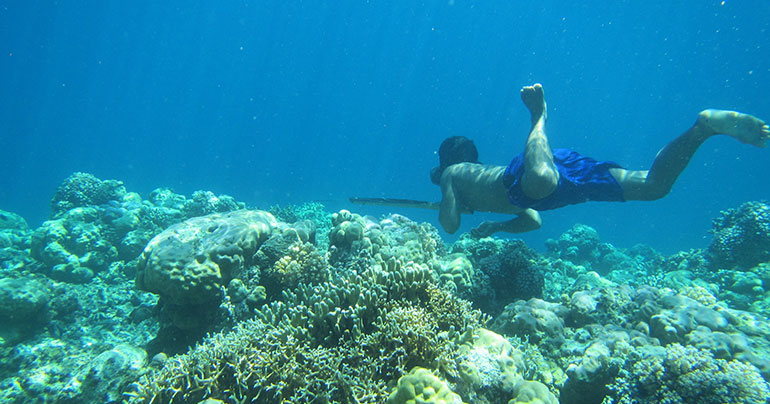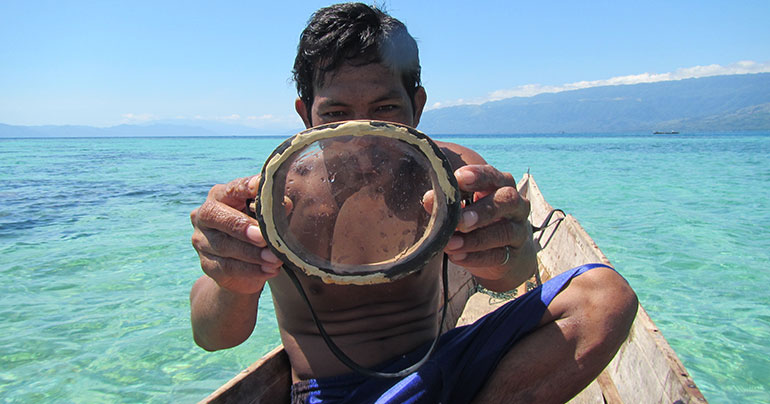As a snorkeler you have two options if you want to increase your time underwater: either you can train to increase your lung capacity or you can increase the amount of red blood cells in your body. But the ‘sea nomads’ of Southeast Asia have developed a third option: they have doubled the size of their spleens

The sea nomads, called Bajau, live on the fringes of the ocean in Indonesia, Malaysia and the Philippines, while others still reside along the coast of the Indian Ocean in Thailand and Myanmar. A recent study published in the scientific journal Cell documents how the Bajau have, over the course of hundreds of years, developed their envious ability to stay underwater for minutes at a time, diving for fish, sea cucumber and crustaceans in depths down to 70m.
The spleen acts as a reservoir for oxygenated red blood cells, injecting these cells into your system as you dive to give you an oxygen boost. In this sense, it is acting as a biological scuba tank. Through their larger spleens, the Bajau have larger ‘tanks’ and thus more oxygen, which allows them to stay underwater for longer. But how do you get a 50% larger spleen?
It all boils down to the genes.
Researchers from the Natural History Museum at the University of Copenhagen in Denmark and the University of California at Berkeley scanned the spleens and took spit samples from 59 diving Bajau in Indonesia and from the neighbouring non-diving Saluan community, and found that the Bajau – whether they were divers or not – had a 50% larger spleen than the Saluans.
When the researchers analysed the genes of the Bajau, they found that one site of a gene known as PDE10A correlated with a larger spleen size. In rodents, PDE10A is known for regulating a thyroid hormone that controls spleen size. This is a strong indication that the Bajau have evolved a larger spleen size necessary for their long, deep dives.

Adapting to a new or hostile environment doesn’t happen overnight, and the Bajau may have had this extraordinary ability for centuries or even thousands of years.
“At the moment there isn’t a definitive method for pinpointing the time the process of adaptation began. So we don’t really know,” explained Melissa Ilardo of the University of Copenhagen, the study’s lead author. “The mechanism is classical natural selection. Those who happen to carry a gene that is advantageous for diving are more likely to survive and pass this gene along to their offspring.”
Despite being born with a larger spleen, the Bajau’s unique ability does not necessarily appear from birth.
“We aren’t sure at what point in life the advantage begins to manifest physically. But since there appears to be multiple adaptations, it could be that the onset of each occurs at a different point in maturation and development,” Ilardo said.
The new findings may prove to have some valuable side benefits. The way the human body responds to diving conditions simulates acute hypoxia with rapid depletion of oxygen. This is a leading cause for complications in emergency care. Studying sea nomads like the Bajau can therefore lead to new ways of studying acute hypoxia.
“I plan to present the data to the Bajau to share the results and also plan to take additional measurements to follow up on some of the results we uncovered through this study. I hope to visit some other populations of sea nomads as well,” Ilardo said.
Sadly, many Bajau have already stopped diving. There is tremendous financial and societal pressure placed on them to provide seafood for a large part of Asia, which means they have to increasingly switch to commercial fishing practices. These are more dangerous for the Bajau themselves and less sustainable for the ecosystem.
Uffe Wilken is a Danish science writer and communicator. His main focus is on science and nature in the Arctic and in Southeast Asia.

